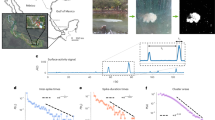Summary
This paper is concerned with a model for the interaction of certain behaviour patterns of a fish (Pelmatochromis subocellatus kribensis BOUL; Cichlidae). Five behaviour patterns (schooling behaviour, locomotion, biting, fleeing, camouflaging) are described as a function of four external stimulus patterns (CO2-concentration, school-signal, conspecific's signal, frightening-signal) and three so-called internal states of readiness (readiness to school, readiness to attack with bites, responsiveness to frightening stimuli). In accordance with the statistical appearance of behaviour patterns the model contains five interdependent statistical pulse generators. This model is planned to find and to confirm a theory for a quantitative description of behaviour patterns, the interdependencies of which give a representation of the internal structure of the organism.
Similar content being viewed by others
Literatur
Heiligenberg, W.: Ursachen für das Auftreten von Instinktbewegungen. Z. vergl. Physiol. 47, 339–380 (1963).
Heiligenberg, W.: The effect of external stimuli on the attack readiness of a cichlid fish. Z. vergl.Physiol. 49, 459–464 (1965).
Holst, E. v., u. U. v. St. Paul: Naturwissenschaften 18, 409–422 (1960).
Baerends, G.P.: La reconnaissance de l'oeuf par le Goéland argenté. Bull. Soc. Sci. Bretagne 37, 195 (Abb. 1) (1962).
Author information
Authors and Affiliations
Additional information
Herrn Professor Dr.-Ing. Marko danke ich für die Arbeitsmöglichkeit an seinem Institut. Ihm, meinen Kollegen Herrn Dörbschridt und Herrn Piatzer sowie Herrn Dr. Heiligenberg, bin ich für viele wertvolle Anregungen und Hinweise verbunden.
Diese Arbeit entstand mit Unterstützung der Deutschen Forschungsgemeinschaft.
Rights and permissions
About this article
Cite this article
Hauske, G. Ein Elektronisches Funktionsmodell für Verhaltensweisen eines Fisches. Kybernetik 3, 27–33 (1966). https://doi.org/10.1007/BF00291088
Received:
Issue Date:
DOI: https://doi.org/10.1007/BF00291088




